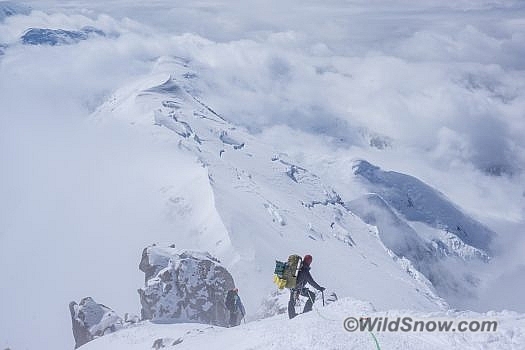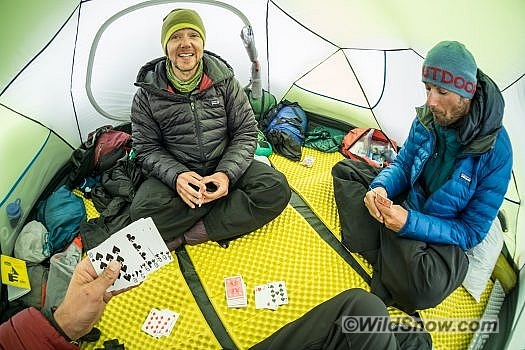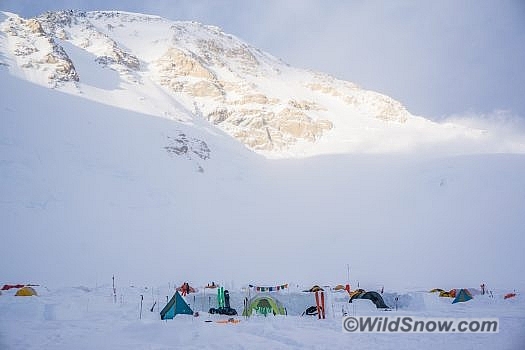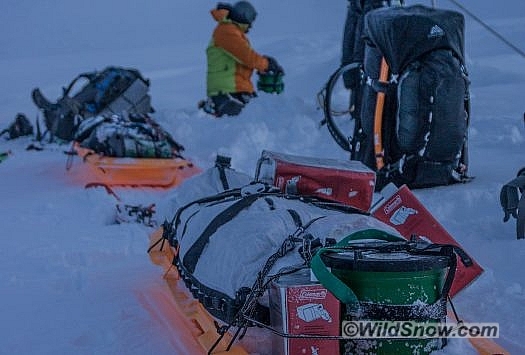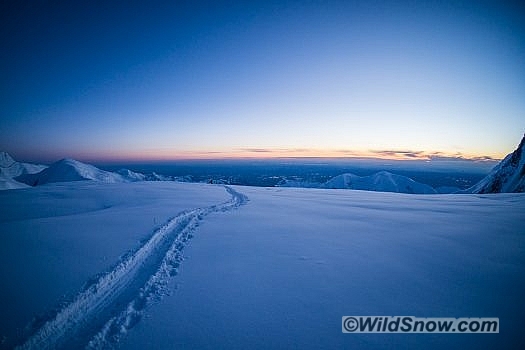Leif Whittaker
(Post sponsored by our publishing partner Cripple Creek Backcountry.)
Back at 17 Camp after a four-hour descent, we had enough energy to make dinner, but we were too tired to eat. Our bags of rehydrated slop froze solid while we listened to the forecast. The National Weather Service had issued a high wind warning for the following day. This news, though unsettling, didn’t disturb my deep and dreamless slumber.
A couple small teams raced to the summit the next morning, including the Swedish Vikings, who had needed a rest day after their ordeal with the avalanche. Otherwise, 17 Camp was clearing out. Even the park service climbing rangers were heading down.
We escaped through swirling clouds, our toes banging into the ends of our boots as we shuffled down the fixed lines. We briefly considered making a mad dash for base camp that night, but we needed more time to organize our gear and recover, so we planned to leave in the morning.
The Swedish Vikings called us on the radio and said they had reached the summit just before the wind arrived. Now they were huddled in their tent at 17 Camp, watching the walls cave in with every powerful gust. We looked at the buttress and saw a giant plume of spindrift trailing off to the north. 14 Camp was placid. How long would that last?
Beer and hamburgers on our minds, we struck camp in the morning and gave away most of our food, including our last can of tiny smoked oysters. The plan was to ski directly to base camp and we only needed light snacks for the journey. Two hours later we were packed and ready to depart, but by that time the weather had deteriorated. Visibility was zero and windblown snow had already covered the track to Windy Corner. I knew we were screwed ten steps from camp. We made the obvious decision to turn around. So much snow was falling that we struggled to identify our campsite. We anchored the tent, dove inside, and took stock of our situation. Big storm. No oysters. But it could have been worse. At least we had a deck of cards.
The drifts at 14 Camp were more than three feet deep on the morning of June 11. Jeremy, who had become a good friend over the last weeks, came over to discuss options. Like us, he needed to descend to base camp and he was hoping we would share the burden of breaking trail. We agreed to attempt it.
An hour later, with full packs and sleds, we met Jeremy and his team at the corner of camp. Then began a classic game of chicken, each team waiting for the other to set off first. We won, of course, and as we watched Jeremy plunge forward on snowshoes, our resolve weakened. Brandon was our avalanche expert and he wasn’t comfortable with the idea of skiing Squirrel and Motorcycle Hill in several feet of unsettled snow. Bad feelings must not go unheeded in the mountains, so again we bailed.
Instead, we spent the day thinking about all the food we had given away. The evening forecast indicated that a worse windstorm would arrive later that night and could last for a week. The Swedish Vikings were still trapped at 17 Camp, where the wind was again gusting to 70 m.p.h. Thankfully, they had plenty of food and fuel, and a bombproof tent.
At about 8pm, the sky cleared, and we saw more spindrift blowing off the ridge. 14 Camp was calm, however, and we looked across the Alaskan lowlands at an empty horizon.
“What if we go for it tonight?” Brandon asked.
Mike and I were skeptical at first, not wanting to be trapped in a bad location when the storm hit, but as we talked more, Brandon’s argument began to make sense. The new snow had settled for about 16 hours and this window, however miniscule, might be our only chance to escape in the next week. We packed frantically, one eye on the twisting plumes that were drawing closer every minute. At 10pm, a powerful gust carried a billowing sheet of snow across the lower Orient Express, less than 500 vertical feet above us. It was now or never. We tightened our harnesses, cranked down our ski boots, and went for it.
Roped up with two sleds between us, we skied away from 14 Camp, a ceiling of wind chasing us down the mountain. The only tracks were from Jeremy and his team who had departed about 12 hours earlier. We were the first group to ski it. We tried to keep the sleds upright and the rope taught, but it was incredibly awkward, especially for Mike, our token splitboarder.
To make matters worse, the section between 14 Camp and Windy Corner was heavily crevassed. Jeremy’s footprints punched into several bottomless holes. Progress was agonizingly slow. We crashed and wallowed while a snow tornado twirled down the West Buttress. Finally, we rounded Windy Corner, which remained mercifully calm. With fewer crevasses below us, we decided our best option from there was to ski unroped. Brandon and I each took a sled, giving Mike the pleasure of riding without one. Our main concern now was an avalanche.
Because Squirrel Hill was so exposed and the sleds so unwieldy when dragged behind us, Brandon and I decided to carry them like briefcases, albeit 50-pound briefcases. Fighting imbalance with every muscle in my body, I skied last through champagne powder to our cache at 11 Camp. The slopes held, and so did my arms, barely.
From there, the terrain eased off and we could tow the sleds again. They swung from side to side with each turn, gaining speed until they inevitably caught an edge and barrel rolled. With empty fuel cans lashed to the outside of his sled, Brandon looked like a car decorated for newlyweds. We laughed ourselves to tears as we watched each other ski through the twilight of the Alaskan night.
Nine hours after departing 14 Camp, we crested Heartbreak Hill and spotted Jeremy’s team resting near the landing strip at base camp. They had just arrived.
Soon we were flying over a verdant countryside. On the 20th day of our expedition, we stepped into the muggy sunshine of Talkeetna. To understand the importance of such an experience would require long reflection, but for the time being, our desires were simple. Beer. Burgers. Ice cream. Shower. And finally, after 36 hours without, sleep.
As for the Swedish Vikings, they were trapped alone at 17 Camp for six days in winds that topped out at 90 m.p.h. After escaping to 14 Camp, they continued their descent, only to be caught above 11 Camp in another storm, this time with two Canadian strangers. The four of them sat in each corner of one tent, holding it up against the wind for 80 hours straight, until a tiny break in the weather allowed them to escape to safety. They lost a lot of weight and suffered temporary numbness in some toes but were otherwise unharmed.
In many regards, our adventure on the West Buttress was what any climber or skier could expect. It was beautiful, memorable and rewarding, and also incredibly challenging, grueling and dangerous. Decisions that at first seemed small and inconsequential could easily cascade into life-and-death situations. Even if all our decisions were correct — far from it! — an element of chance determined our failure or success. The mountain offered countless lessons, most of which must be lived to truly understand, but here are a few simple and essential reminders: climb with good teammates, don’t make fun of their nose guards, and never ever give away your tiny smoked oysters.
(Born into a family of tall and loud mountaineers among the glaciated spires of the Olympic Mountains, guest blogger Leif Whittaker blames his lack of skiing talent on his high center of gravity. He has twice climbed to the summit of Mount Everest and he currently works as a climbing ranger for the USFS on Mount Baker. His first book, My Old Man and the Mountain, was published in October 2016 by Mountaineers Books.) My Old Man and the Mountain: A Memoir
Beyond our regular guest bloggers who have their own profiles, some of our one-timers end up being categorized under this generic profile. Once they do a few posts, we build a category. In any case, we sure appreciate ALL the WildSnow guest bloggers!

